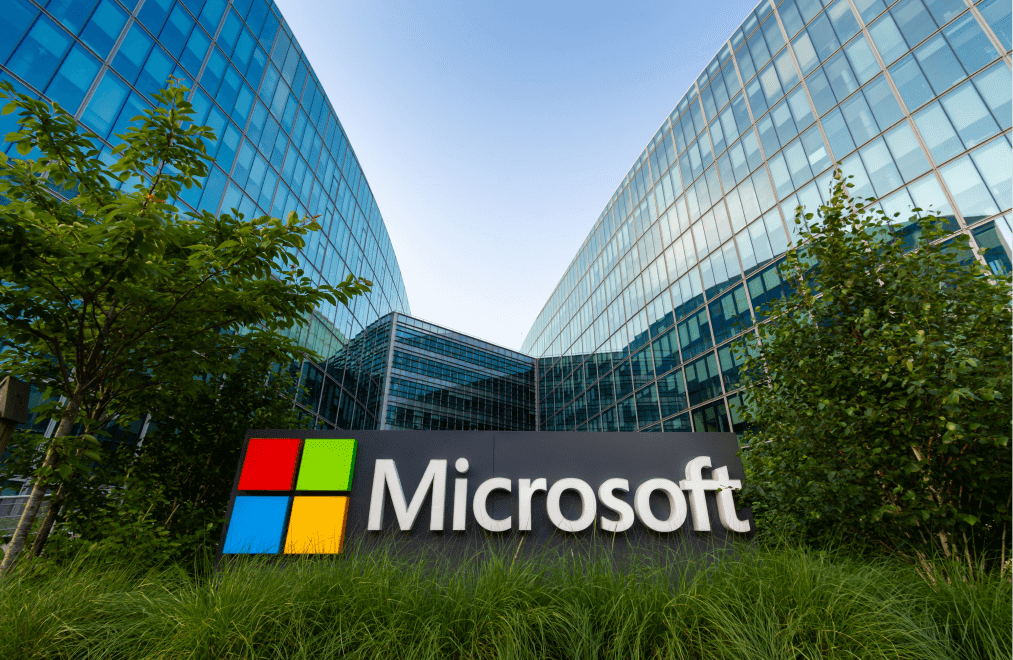How to trade Microsoft shares: a complete guide

Learn all about what Microsoft is, its share trading hours, and how to trade Microsoft share CFDs with Capital.com.
Go to market page
What is Microsoft?
Microsoft is an international technology company specialising in the development and sale of a wide range of enterprise and consumer software, hardware, electronics and services.
Founded by Bill Gates and Paul Allen in 1975, it began as a software company focused on developing and selling programming languages for the Altair 8800 computer. In the early 1980s, it gained prominence with the release of MS-DOS, the operating system for IBM-compatible personal computers, and introduced Windows, the popular graphical user interface for personal computers (PCs), in 1985.
Today, Microsoft is a multinational technology conglomerate with a diverse portfolio spanning cloud services, productivity tools, gaming, hardware, and enterprise software, making it one of the largest and most influential companies in the world. In April 2019, it gained a trillion-dollar market capitalisation, becoming only the third trillion-dollar American company after Apple and Amazon.
Over the past five years Microsoft stock has increased dramatically, largely due to the success of Office, Azure and commercial cloud services. In the 2023 fiscal year, the company’s revenue amounted to $227.58bn.
What is Microsoft’s share price history?
Microsoft’s share price history began when it listed on the Nasdaq Stock Market on 13 March 1986 at $21 a share.
In the period from the 1980s to 2000, the global tech boom helped to drive Microsoft’s stock higher. PCs became an indispensable part of business and personal life, creating demand for further technological innovation and the need for hardware and software, capable of keeping up with the growing demand.
However, from 2000 to 2002, Microsoft stock saw a decline in its growth prospects. While the company’s two major cash cows, Windows OS and Office, helped to bring consistent earnings and revenue, the company took a back seat in the smartphone, portable music player and tablet markets, giving away its status as a major market mover to its rivals in the tech world.
During the period from 2013 to the present day, Microsoft’s share price saw a dramatic upturn, with a fresh focus on cloud-based services. Azure grew into a major rival of Amazon Web Services, helping bolster the share price. However, 2022 saw the stock experience a significant downturn, driven by rising inflation and slowing consumer demand, with the PC market particularly impacted. That year, the share price began at around $335 but sank as low as $217.
However, since then, the stock rebounded to hit record highs. In 2024, the company’s large stake in AI offerings assisted in revitalising interest in the company, and its AI tool Microsoft Copilot for Security, a timely introduction in an era of diverse cybersecurity threats, helped elevate the Microsoft price to around $430 a share.
*Microsoft stock price data from Macrotrends. Correct as of 27 March 2024. Historical price data is inclusive of the effect of stock splits.
Past performance is not a reliable indicator of future results.
What factors might affect the Microsoft share price?
Microsoft’s share price can be impacted by a range of key fundamental events that can impact its many divisions in diverse ways. Here are a few of the main factors that traders should watch out for.
- Product launches and innovations: the media and consumer reception to Microsoft’s new products and services can be a critical driver of price. Specifically, updates to the Windows operating system, Office 365, Azure services, and new iterations of the Xbox console, can all impact sentiment.
- Earnings reports: quarterly earnings reports are an important way for market participants to understand how Microsoft is tracking in terms of sales, profits, and earnings per share. If results are different to analysts’ expectations, the share price may move accordingly.
- Macroeconomic conditions: the strength of the economy, and the subsequent level of consumer confidence, can have a significant impact on sales for any business. For Microsoft, an economic downturn may lead to reduced IT spending by businesses, impacting the cloud services and enterprise software segments.
- Competition: Microsoft faces intense competition whether in cloud services, gaming, operating systems, or any of its other numerous divisions. Market share trends and strategic moves from rivals are all liable to recalibrate the company’s position in its respective sector, and cause its share price to shift. For example, the $7.5 billion 2018 acquisition of software development platform GitHub afforded Microsoft the means to gain market share in the developer tools and collaboration space, adding a new dimension to its service offering and giving traders and investors a new reason to buy shares.
- Regulatory landscape: antitrust investigations, privacy regulations and government policy shifts are all examples of how the regulatory landscape can affect how Microsoft applies its strategy and deliver sustainable growth. This means factors often outside the company’s control can drive price movements.
What are Microsoft’s stock trading hours?
Microsoft’s stock trading hours are Monday to Friday from 2:30pm to 9:00pm (UK time).
If you choose to trade CFDs, you can follow the Microsoft stock performance live in US dollars with the comprehensive Microsoft share price chart.
Monitoring the company’s activity can help you to keep an eye out for any key fundamental or technical events that may affect short-term movements in the Microsoft share value.
How to trade Microsoft shares with CFDs
If you want to take a position on Microsoft shares, you have two options. First, you can buy physical shares in the company through the exchange on which it’s listed. In this case, investing in Microsoft stocks means you will own a share, or shares, in the company. This can be considered a long-term investment, as you’re hoping for the price to rise over time.
Alternatively, you can trade a derivative product such as a contract for difference (CFD) on the underlying Microsoft stock market price, and speculate on its price movements without actually owning the asset. A CFD is a financial contract, typically between a broker and a trader, where one party agrees to pay the other the difference in the value of a security, between the opening and closing of the trade.
Unlike physical share ownership, you can either hold a long position (speculating that the price will rise) or a short position (speculating that the price will fall). This is considered a short-term investment or trade, as CFDs tend to be used within shorter timeframes.
Another key difference between buying physical Microsoft shares and trading through a derivative is the leverage that can be employed with the latter. CFDs are typically traded on margin, which means that a trader has exposure to larger positions with a relatively small outlay. This is also known as leveraged trading, where both your profits and losses are amplified, making the practice risky. You can learn how to trade shares in our comprehensive guide to shares trading.
To trade Microsoft stock CFDs with us, just sign up for a Capital.com account, and once you’re verified, you can use our advanced web platform or download our intuitive yet easy-to-use app. It’ll take just a few minutes to get started and access the world’s most-traded markets.
Why trade Microsoft CFDs with Capital.com?
Trading CFDs with Capital.com means you’ll enjoy an intuitive, supremely easy-to-use platform, 24/7 support, fair and transparent pricing, along with award-winning education to help build your experience in the markets.* You can seamlessly integrate our smart platform with elite third-party software TradingView and MT4, and refine your strategies with our risk-free demo.
*Awarded best-in-class for education at ForexBrokers.com’s 2024 Annual Awards
FAQs
What is the Microsoft stock price?
As of 27 March 2024, Microsoft’s stock was priced around $421 a share, but as with any asset the market price is dynamic and liable to change at any time. If you’re trading this stock, it’s important to check the Microsoft chart frequently to keep on top of price movements, as well as retain a strong understanding of the fundamental and technical influences that can cause the price to shift.
Who owns Microsoft stock?
The ownership of Microsoft stock is mostly comprised of institutional investors. As of 27 March 2024, major shareholders included Vanguard Group, Blackrock, and State Street Corp, but it’s important to understand that ownership patterns are dynamic, with large share sales or purchases liable to change the picture.
Is Microsoft a good stock to buy right now?
Whether Microsoft is a good stock to buy is dependent on market conditions and the individual judgement of traders. On a technical level, you might consider technical indicators such as the RSI or MACD to identify potential support and resistance. From a fundamental standpoint, a knowledge of vaccine development news, the standing of competitors, earnings release timings, and the regulatory landscape are all key factors that could influence your buy or sell decisions.
Who are Microsoft’s main competitors?
Microsoft has many competitors across its numerous divisions. For example, in its operating systems division, Apple macOS is a key rival, as well as Linux. Across its cloud services arm, key competitors are Amazon Web Services and Google Cloud, while in gaming, the Microsoft Xbox competes with Sony and its Playstation iterations as well as Nintendo.
Visit our other complete guides

How to trade NIO
